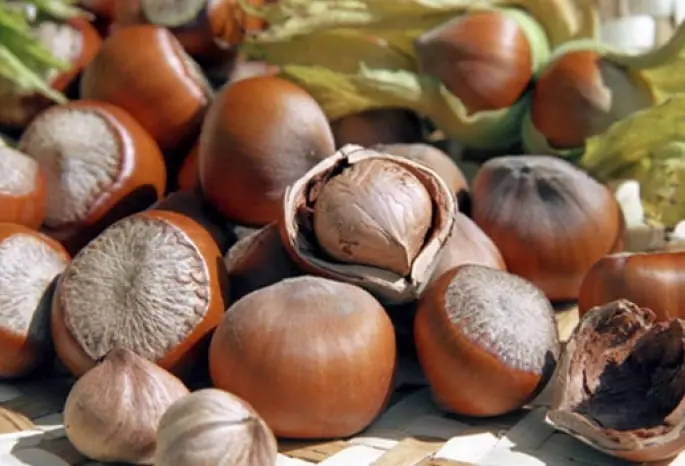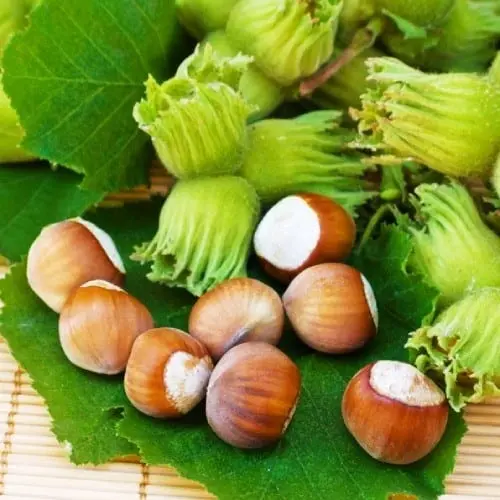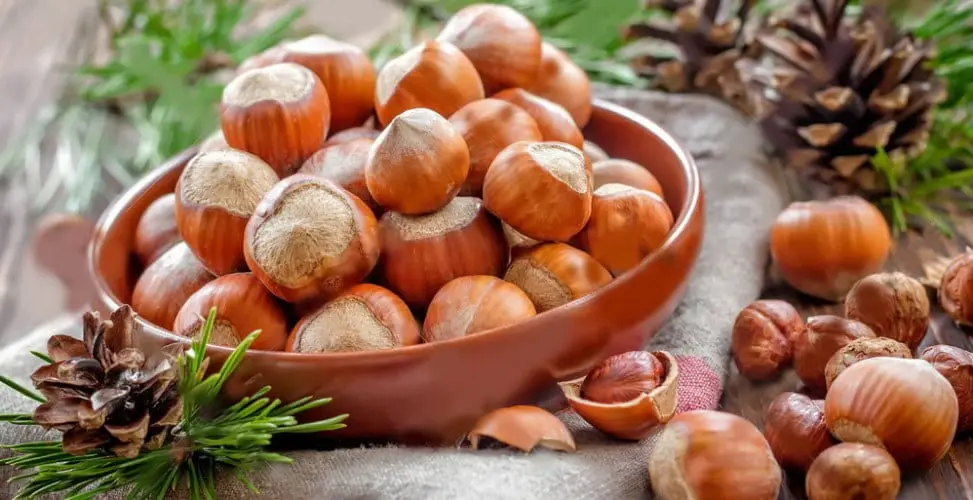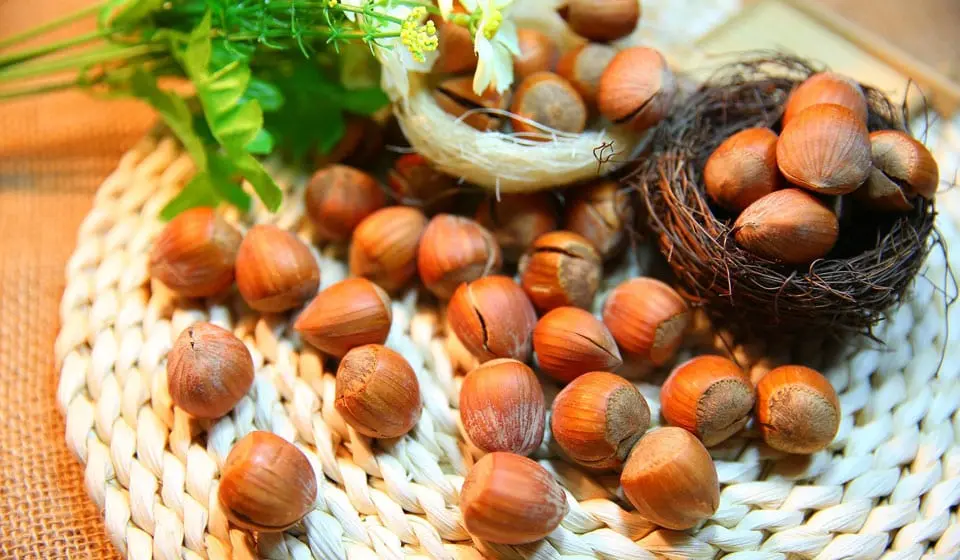Contents
Description
Hazelnut is a valuable and healthy product. No wonder connoisseurs call it the king of nuts. There are also many superstitions associated with this delicacy. With its help, in ancient times, they removed the evil eye, drove away a thunderstorm, fought against snakes and evil spirits.
The nut, which we are used to see on cakes in the form of sprinkles, being fresh can do much more good. We will find out how much hazelnuts can be eaten per day and how it affects the body.
It has been known to mankind since the Neolithic times. Asia Minor and the Caucasus are considered his homeland. Today there are about twenty species of this plant, and it is grown in many countries with subtropical or temperate climates.
The fruits themselves are oval in shape. But in the supermarket or in the store, you can only see round nuts. This is a cultivated type of nut called hazelnut. He is no different from his forest brother, except in size. Its kernels are larger, which means more useful.

Composition and calorie content
Any nut, and hazelnuts in particular, is a storehouse of vital vitamins and minerals, a real concentrate of health. In the kernel of cultivated forms of hazelnuts, the sum of proteins, fats and carbohydrates reaches 98%, for comparison: in wheat bread – 51%, in meat 30-46%, and in potatoes – 22%.
The kernel contains 20 amino acids, which form complete proteins, in terms of calorie content it is 668 kcal per 100 g, while 200-300 g of nuts provide the daily requirement of an adult.
- Proteins 14.95 g
- Fat 60.75 g
- Carbohydrates 7 g
Hazelnut history

Hazelnuts are the fruit of the Lombard nut. The fruit is covered with a hard shell and the kernel is about half the weight. The shrub can grow up to 10 meters in height, grows in the southeast of Europe and in Asia Minor in the wild. Hazelnuts begin to bloom in early spring, and the first nuts appear on it in early autumn.
Hazelnuts are often confused with hazel. Meanwhile, the latter is the wild progenitor of hazelnuts; hazelnuts have small and less aromatic nuts. When they began to cultivate it, a special variety was bred – hazelnuts. It is often referred to as hazelnut.
This nut was known back in the days of Ancient Greece. Hazelnuts are considered one of the most delicious and fragrant nuts, especially young fruits – “milk nuts”.
The young hazelnut kernel does not have time to overgrow the hard inner peel, remains white and tender, crunches on the teeth. The old fruit has a more pronounced nutty flavor, but the skin must be peeled off separately.
The benefits of hazelnut

Hazelnuts are very nutritious and are considered a “calorie bomb” – their energy value surpasses even chocolate. Therefore, a handful of hazelnuts can replenish the supply of strength for a long time. It is often eaten by athletes and people engaged in active physical work.
This nut contains up to 60% fatty oils, which consist of glycerides of oleic, stearic and palmitic acids. They protect and strengthen blood vessels, and are also important during the stage of active growth. Hazelnuts contain a lot of protein, which is needed to build the body’s own cells.
There are a lot of vitamins B1, B2, C, E in hazelnuts; as well as minerals: potassium, iron, cobalt, phosphorus, calcium, zinc. These connections are necessary for the normal functioning of all systems and organs.
Hazelnuts are allowed to be eaten by patients with diabetes due to their low glycemic index. At the same time, the use of nuts will reduce the risk of vascular complications.
Hazelnut harm

Hazelnuts are considered an allergen, like many nuts. Therefore, this product should be introduced into the diet of children and people with allergies carefully so as not to cause a sharp reaction. It is not recommended to eat nuts during an exacerbation of diseases of the stomach and intestines, so as not to irritate the mucous membrane. For a diseased liver, hazelnuts can also become too heavy a food.
The daily intake of hazelnuts is up to 30 – 40 grams. In one nucleolus, on average, 2-3 grams, so you can eat two portions of 5-8 nuts per day.
The use of hazelnuts in medicine

Hazelnuts contain a substance called paclitaxel, which is used to treat certain types of cancer. Paclitaxel was found in all parts of the hazelnut by sheer coincidence when Oregon researchers were looking for the cause of the tree’s fungal disease. It was found that nuts secrete a substance to protect against fungi that attack the shrub.
Paclitaxel inhibits the cell’s ability to multiply and prevents the growth of malignant tumors. True, it is not yet known whether there will be any effect for the treatment of oncology from taking nuts in their pure form. A specially selected substance is used for therapy.
Hazelnuts are good for the heart and blood vessels, due to the high content of potassium it is recommended for “cores”. In folk medicine, diuretic tea is made from hazel leaves. It has firming properties and helps eliminate toxins.
Hazelnut oil is used in cosmetology. They nourish the skin, make masks for hair and nails, add to scrubs as a base, so as not to damage the skin with hard particles. Hazelnut gruel was previously used as a hair dye. The walnut gave them a chestnut hue.
The use of hazelnuts in cooking

Hazelnuts are eaten not only in their pure form, but also added to various dishes, even soups. And from crushed nuts they make kozinaki, nut butter.

Useful cookies for those who preserve their figure or do not eat gluten, which is rich in wheat flour. You can use any nuts to your taste. Can be cooked with both roasted and fresh nuts.
- Almonds – 65 gr
- Hazelnuts – 65 gr
- Sugar – 55 gr
- Egg whites – 1 piece
Grind the nuts in a mortar or blender until finely crumbled, do not turn them into flour. Next, mix the nut crumbs with sugar. Beat the whites of one large egg or two small eggs separately until firm white peaks.










Òrmon yonģoģini ekish parvarishlash tòģrisida tushuncha bering